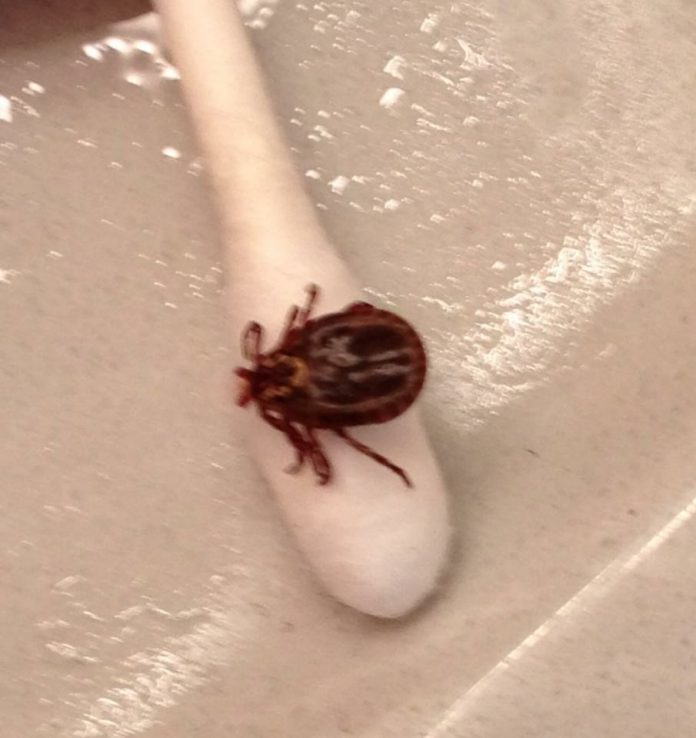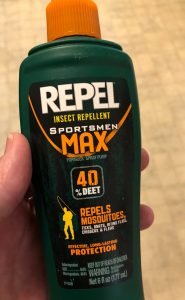
It’s Tick Season out there, and whether you are a a sport shooter, a hunter, or just a backyard birdwatcher, you are likely to run into these pesky disease-carrying ectoparasites. So here is some background and also some resources for how to protect yourself.
Ticks are blood-feeding arthropods of the Class Arachnida. Yes, the same Class as spiders – because adult ticks have eight legs. There are many different genus and species of ticks in North America and most of them are known to carry one disease or another, and sometimes more than one at the same time. Because of this you don’t want to be cavalier about tick bites.
TICKBORNE DISEASES
Depending upon your geographic area, a tick bite may expose you to any one of several different diseases including: Lyme Disease, Babesia, Anaplasma, Ehrlichia, Rocky Mountain Spotted Fever, and Tularemia.
Here is a link to some maps from the CDC which show the distribution of several tickborne diseases based on 2016 data.
In addition to the bloodborne tick pathogens you want to avoid, there is another tickborne human health problem out there called Alpha-gal Syndrome, which is a tick bite-induced allergy to red meat. This is still pretty rare, and researchers are still learning about it, but a new and interesting research tidbit is that blood groups B and AB may be less susceptible to the syndrome.
In addition to the above there is a condition which is more common in children than adults, called Tick Bite Paralysis.
All of these issues combine to form a pretty solid wall of evidence why you and your family should get serious about preventing tick bites.
TICK LIFE CYCLE
The life cycle of your average tick runs through several phases. The CDC has a good page of illustrations for understanding the tick life cycle.
Some tick types are particular about the species from which they take a blood meal, and some aren’t. Ticks can feed on mice, deer, frogs, birds, and a partridge in a pear tree, besides humans. And if any other those animals are carrying any of the above diseases, the tick takes the disease germs along with it when it goes, and then passes them along to the next creature it feeds on. Some ticks can take up to three years to finish their life cycle, with each stage of tick capable of acquiring and spreading disease through the blood meal.
Because of the way that ticks hitch a ride, it is possible to get a tick bite from simply walking through the grass on your shooting range, or even your backyard. So don’t think that you are free from exposure just because you don’t hunt or hang out in the woods. I once acquired a tick just by walking through the grass looking at memorials on a Civil War battlefield.
PREVENTION
So, other than locking yourself in the house all day, what can you do to prevent being bitten by ticks? It’s not like you can use your dog’s Frontline on yourself. (and we’ll get to that in a minute)
One of the first lines of defense is using a good insect repellent. And I mean “good”, not just some essential oil stuff your neighbor sells. Here is a link to the EPA website for repellants , which can help you decide what type of bug repellant to use for your needs.

Another preventive measure you can take is to wear long pants and long sleeves. Tucking the hems of your pants inside your socks also helps. (Better to be protected than to look cool, right? But you can leave the pocket protector at home.)
The usual suggestion to wear light-colored clothing is not really helpful when your outerwear is camo patterned, but if you are just in the yard or hiking a trail, that suggestion makes it easier to find and remove ticks which may be attached to your clothing.
To allow your clothes to provide a better barrier, you may consider treating your outerwear with permethrin. This is the same stuff that they soak bed nets in for the tropics to help keep malarial mosquitoes at bay. It’s also the same stuff that is in over-the-counter lice shampoo. Permethrin is a synthetic derivative of the chrysanthemum plant, which persists on the treated clothing through several washings, and kills the ticks after a few seconds of contact. This keeps the bug from ever getting to your skin in the first place.
Though permethrin is fatal for ticks and other bugs, it is safe for humans, and even toddlers. Just not cats. Cats do not process permethrin the same way dogs and people do, so keep your supply away from Fluffy. You can buy clothing which has been pre-treated, but you can also buy permethrin for treating your own clothing at home. An Amazon search for permethrin turned up several options and a good outdoor store or farm supply store should also carry it.
In addition, this hunting blog claims that permethrin is odorless and should thus not provide a scent signature that would ruin your deer hunt. For that reason, I bought concentrated permethrin at Tractor Supply and am going to try it.

Even if you do pick up a tick during your day, getting them off before they attach to you will still be protective. When you get back home, experts recommend that you check yourself for ticks and have someone else check you if possible. They also recommend stripping off clothes and scrubbing yourself well in the shower to remove ticks before they attach. When checking yourself or others for ticks, don’t forget to check the hidden crevices and crannies like armpits and what is medically known as the “gluteal cleft”. Ticks hitching a ride at your ankles will gradually climb farther up before attaching, often stopping in this region.
If you find a tick has already bitten you and attached itself, prompt removal is key. Research varies, but most indications are that disease transmission requires tick attachment for 48-72 hours, so the sooner you find the critter and remove it the better. Recommendations are to remove the tick with tweezers. Older home remedy methods including using a hot matchstick or petroleum jelly are not recommended.
Once the tick has been removed, clean the area with soap and water and apply an antiseptic. It is not currently recommended for your doctor to give you antibiotics for a simple tick bite, unless you have serious underlying medical conditions. Current recommendations say that you should monitor yourself, and see your doctor if you develop a rash at the bite site or other symptoms such as fever and fatigue.
FUTURE PREVENTION
You may reasonably ask why there is a Lyme vaccine for dogs, but not for people? This link provides an interesting answer. The vaccine certification process for humans is complex and lengthy, with many hitches in the road. Apparently a vaccine was tried in the 1990’s, but there were hitches.
Who knows what the future holds for tickborne disease research and prevention. Maybe in twenty years we’ll be able to swallow a seasonal bite-prevention pill like your dog does. For the foreseeable future however, we’re stuck with what we’ve got – stinky bug spray, barrier clothing, and personal inspection.
Be safe out there. Your future health may depend upon it!



